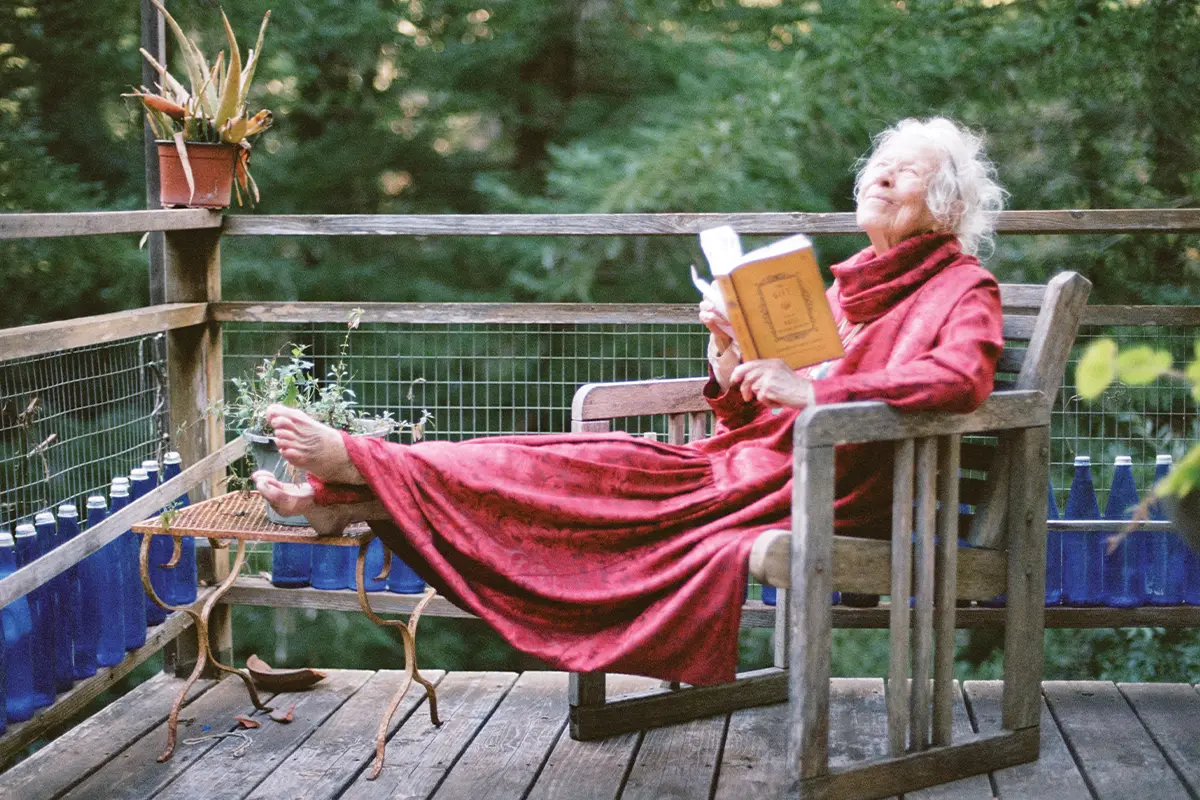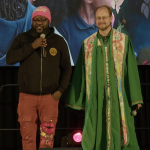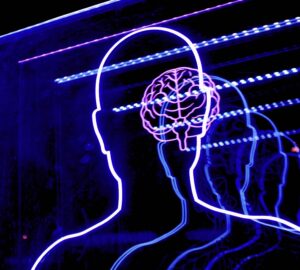“I’m the wrong one, in a way, for a psychedelic magazine because I didn’t do psychedelics,” Penny Vieregge tells me, sitting under a flowering plum tree hung with crystals, her hands wrapped around a silver goblet. Except for that one time she tried LSD, of course, and the six-ish months she spent self-administering “yagé” — which she describes as “a mixture of ibogaine and ayahuasca.”
We’re on the wraparound porch of the Lincoln log cabin in Big Sur, CA, where she makes her home with towering, dusty bookshelves and hundreds of jazz and classical cassettes—Mozart and Schubert and Mingus and Fitzgerald. Her home is so intertwined with the landscape of Sycamore Canyon, the winding road that leads to the famous beach with the purple sand, that she once found a family on vacation having a picnic in the middle of her driveway.
I had the luck of living in a one-room studio next door for a summer years ago, driving her to therapy and choir practice and the monk’s hermitage, and she has been my friend ever since. When I’d come home late at night, I’d hear her playing the piano up there, alone in her cabin, silhouetted in the window, Bach floating out on the night.
Penny is both scrappy and elegant—if you stay late enough, she might serve you a glass of Courvoisier or wine in a crystal vessel repaired with super glue. She wears sarongs in warm weather, thrifted cashmere on cold nights, and heavy pieces of Big Sur jade around her neck.
Subscribe to the Drop In by DoubleBlind. Your essential newsletter covering the world of psychedelics. Trusted by 100k+ readers.
At 95 years old, she identifies as a crone, evoking the once-revered crones and witches of yore.
For her sixtieth birthday, she asked the women in her life to host a Crone Ceremony, announcing her intention to walk this path with the support of her community. Her friends and family represented the stages she had lived, as maiden and as matron, and formed a birth canal of arched arms leading to her throne.
Today, a warm day in the canyon, she welcomes me in by throwing her arms around my head and offering some ginger tea that’s been steeping and reheating all season or some of her “gnarly coffee.” She asks me to squeegee the dew off the redwood table so we can sit in the sun and a shaft of light graces her chair.
Penny moved to Big Sur in the 1970s after becoming disenchanted with her life as a Marin housewife, first living out of a tent and leaching acorns in the creek to make acorn meal, and later in a double-wide trailer with her three children. She remembers those early years, living on food stamps and gifting the kids a box of Kix for Christmas, as happy ones. Eventually, her husband Paul rejoined them all and this is where she’s been ever since. Big Sur was her home and she knew it.
At the time, Esalen Institute—which sits on grounds that have been a site of healing for the Esselen Tribe for more than 6,000 years—had recently been founded, hosting the likes of Alan Watts, Joni Mitchell, Crosby, Stills, Nash & Young, Fritz Perls (the father of Gestalt psychotherapy), and Abraham Maslow (of Hierarchy of Needs fame). Penny refers to Dick Price, a co-founder of Esalen, as a “dearest, dearest brother.” Both surviving members of a pair of twins, they referred to each other as “my twin” and could “reach into each other’s minds,” she recalls.
Price was inspired to create a place like Esalen after a horrible experience in a mental hospital receiving electroshock and insulin shock treatments during a psychotic episode. In a 1985 interview with San Francisco patients’ rights activist Wade Hudson, he shared a vision for a place “where it’s possible to live through experience rather than having it blotted out” and heal through nutrition and active self-discovery. Esalen was a place where you could eat sprouted bread and soak your bones in mineral pools while attending transformational workshops. Penny worked in housekeeping for a time and remembers hearing the “horrendous screams” of someone processing during a Gestalt session as she carried clean sheets up the hill with her 9-year-old daughter Anna. Worried that her daughter might be disturbed, she looked over to find her unphased. “Nice core sounds!” Anna said. She also remembers a small group of nursing mothers at Gazebo Preschool playing “Pass the Baby,” feeding each other’s children so they would understand themselves as part of a benevolent universe.
Part of her kindredness with Dick may have been in their mutual experience with liminal places in the mind, with becoming untethered and circling back. Penny experienced her own psychotic break when she was in college, bereft after her mother forbade her from becoming a nun, and spent the year “fugueing” with no memory of what she had done throughout the day. She was dropped from the Dean’s List and expelled, only graduating after the president and chancellor of the school advocated on her behalf.
“I still miss him,” Penny says of Dick, and offers me a poem she wrote after he died in a tragic hiking accident in Hot Springs Canyon at the age of 55:
You were a crystal gathering light.
All who came near were bathed in color.
Some saw you only red…
Some blue.
Only one knew your clear green.
She who was your mate.
I, your twin, strolled through the spectrum.
My world still dances with reflections of your prismatic love.
That day, on the lodge wall, a truth was written.
A light bearer moves on.
His light remains.
This is how conversations go with Penny. They are always threaded with poetry, often introduced with an exclamation — “Oh!” as if struck — and then a question, “Do you want to hear it?” The answer is always “yes.”
She might deliver an original poem or something she knows by heart, written by the 17th century metaphysical poet John Donne, but one of her truest dedications in the realm of poetry in recent years has been memorizing Daniel Ladinsky’s renderings of the poetry of Khwāja Šamsu d-Dīn Muḥammad Hāfez-e Šīrāzī (known as Hafez), compiled in his book The Gift. Lately, she has recorded and performed these poems with a trio called Overlapping Halos, accompanied by her friends Edwin Huizinga on classical violin and Deva Munay on alchemical crystal bowls.
She doesn’t identify as having written any poetry, instead the poems “just come,” like visitations. Her spiritual life has always been deep that way. She remembers the feeling of being born into this world, met by a glare of light and the strange feeling of air currents along her wet skin as she was lifted from her mother via Cesarean section. As a young child, she came to recognize a psychic sensibility in herself—something she calls “color talk” that allowed her to see beyond the words people were using. In a moment of telepathy with an old woman who shared her abilities, she was warned that her gifts were dangerous and must remain hidden; she was to tell no one.
Her spiritual sensibility has made her a kind of synesthete with “open-pored reception,” and she remembers the sound of the stars the first time she was invited to sleep at the monk’s hermitage in the Santa Lucia Mountains, many years after moving to Big Sur. The celestial bodies were “big as platters,” way up there with no light pollution, and they sounded like a loud cocktail party that kept her up all night—just in time for the early morning Mass. A lapsed Catholic at the time, it felt like she was in the right place: “This is where I belong,” she thought, and soon found herself playing music with the monks, cutting their hair, teaching them CPR, First Aid, and wound care, and gaining special permission to enter the cloister as a woman. After becoming an oblate at the hermitage, she took the name Damaris, after an Athenian woman in the Bible who came to believe in Christ through the teachings of Paul.
Over the years, Penny has become a pillar of the Big Sur community, teaching generations of preschoolers First Aid and Emergency Preparedness out of a refurbished, broken down bus on the Esalen grounds. She worked in Red Cross disaster relief, founded the Big Sur Cliff Rescue Unit, and served as a volunteer EMT for the Big Sur ambulance, always keeping a bottle of Chanel No. 5 and an espresso pot in her jump kit alongside the medical supplies. She credits some of her energy for community service to the Buddhist practice of brahmacharya, which she learned at the San Francisco outpost of the ARICA school. When she began learning this practice, she was in the midst of a passionate love affair and, when they heard that they would be learning how to darken their sexual channels, they looked at each other and said, “Fat chance.” Within a week, they were no longer having sex, instead experiencing orgasm by gazing into each other’s eyes. This path ultimately led her to a celibate life, containing something of the one she had yearned for in the convent.
“You know,” she tells me, “I considered myself growing up to be a controlled schizophrenic. So people with psychedelics, they didn’t come up with anything I hadn’t experienced on the natch.”
After falling in with the crowd at Esalen, which she describes as having a “pharmacy of psychedelics,” she soon became a “babysitter on tap” for the Spiritual Emergency Network. SEN was founded by Christina and Stanislav Grof, a psychotherapist and psychiatrist credited with being innovators in the psychedelic movement, to support people in the midst of transformative states that might ordinarily get them committed to an institution or treated with psychiatric medications. Penny had plenty of experience guiding people through bad trips from her time working at the Haight-Ashbury Free Clinic. If someone was spiraling out, she would say, “Feel this rope, this line,” and point to three inches above her navel. As soon as they could feel it, she’d tell them to keep touching the tether, knowing they could always return to her, hand over hand, anytime they needed to, and promising them: “I will stay here as your anchor to the planet.”
Most of the time, Penny didn’t have much interest in taking psychedelics herself. When she tried acid, it felt “awful, sharp-cornered, and unnatural,” with “a pressure that needed to be controlled,” and living felt mystical enough as it was. Until one day, during her time as a waitress at Nepenthe—the famed cliffside restaurant of redwood and adobe designed by a student of Frank Lloyd Wright—when she found herself with an intractable problem that she couldn’t seem to get around or through, no matter how hard she tried. When she shared this with Dick Price at Esalen, he offered her a list of psychedelics they had on-hand. She closed her eyes and ran her finger down the page, landing on the word “yagé.” Dick warned her that they had seen three people experience a psychotic break while using their yagé in the last three months alone, and encouraged her to close her eyes and try once more. She traced her finger down the page and there it was again.
The first time she took it, she remembers hawks swooping down from the sky and spreading out inside her body. When I ask her if she became a hawk, she shakes her head. “No, I felt like Penny and these hawks were…” She swooshes her lips and gathers up her arms. “Penny with hawks inside,” I say, and she likes that: “That’s a great song. Penny with Hawks Inside. Friendly hawks!…I was lucky.” She describes the “nourishing” period of half a year where she took this mixture as needed while waitressing and parenting. I don’t hide my surprise that she was simultaneously given ibogaine and ayahuasca, a combination I’ve never heard of, and that she was continuing her usual schedule all the while. “Were you ever incapacitated?” I ask. In response, she tells me a story about her psychotherapist and friend, Jack Downing, who founded the Gestalt Institute of San Francisco, coming up to her at a gathering to address how normal she was behaving after ingesting so much yagé. “Are you noticing anything strange?” he asked. She looked at him, saw a pair of rabbit ears growing from his head, and thought to herself, “I never noticed that before.” All of her visions were simply a new kind of noticing, a gathering of previously unseen facts about the world.
Every day I’ve spent with Penny has had this feeling of natural unfolding and encompassing the remarkable. “Don’t push the river,” she always says. When we spent the summer together, I was struck by her ease and the irreducible complexity of her singular life. On any given day, you might find her singing baritone in the gospel choir or receiving visits from a Santa Cruz surfer who has driven all this way to wash her windows. She never stopped marveling at the big stretch of ocean as we rounded the bend on Highway 1, even with limited vision, as though she could see the feeling of it. She loves what she loves wholeheartedly but keeps her curiosity about everything new. It’s no surprise to take her to dinner and watch a man who is strolling by stop to kiss her head. She may have taught him a song when he was young about which plants are safe to touch or about never turning his back on the ocean. She’s a little bit everywhere like that.
“Penny exceeds herself,” I think, sitting under the plum tree, when she recites a haiku about spring blossoms and a white butterfly, and I notice one fluttering by, just over there.
DoubleBlind is a trusted resource for news, evidence-based education, and reporting on psychedelics. We work with leading medical professionals, scientific researchers, journalists, mycologists, indigenous stewards, and cultural pioneers. Read about our editorial policy and fact-checking process here.
DoubleBlind Magazine does not encourage or condone any illegal activities, including but not limited to the use of illegal substances. We do not provide mental health, clinical, or medical services. We are not a substitute for medical, psychological, or psychiatric diagnosis, treatment, or advice. If you are in a crisis or if you or any other person may be in danger or experiencing a mental health emergency, immediately call 911 or your local emergency resources. If you are considering suicide, please call 988 to connect with the National Suicide Prevention Lifeline.
DoubleBlind Mag Read More



